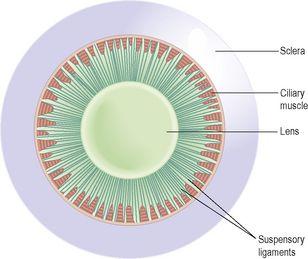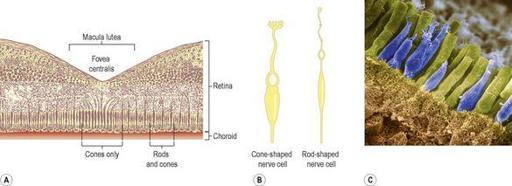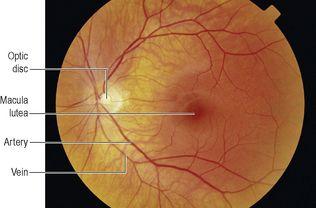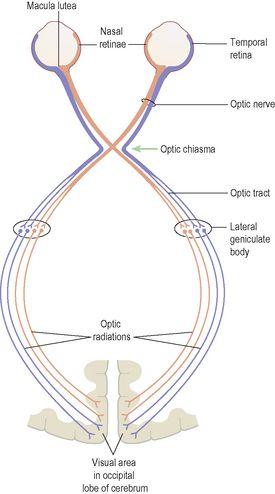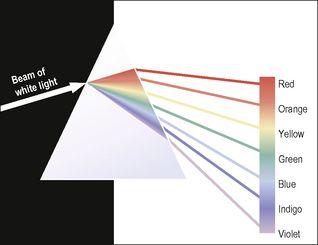Ross & Wilson Anatomy and Physiology in Health and Illness (88 page)
Read Ross & Wilson Anatomy and Physiology in Health and Illness Online
Authors: Anne Waugh,Allison Grant
Tags: #Medical, #Nursing, #General, #Anatomy

Figure 8.10
The lens and suspensory ligaments viewed from the front.
The iris has been removed.
Ciliary body
The ciliary body is the anterior continuation of the choroid consisting of
ciliary muscle
(smooth muscle fibres) and secretory epithelial cells. As many of the smooth muscle fibres are circular, the ciliary muscle acts like a sphincter. The lens is attached to the ciliary body by radiating
suspensory ligaments
, like the spokes of a wheel (see
Fig. 8.10
). Contraction and relaxation of the ciliary muscle fibres, which are attached to these ligaments, control the shape of the lens. The epithelial cells secrete
aqueous fluid
into the anterior segment of the eye, i.e. the space between the lens and the cornea (anterior and posterior chambers) (
Fig. 8.8
). The ciliary body is supplied by parasympathetic branches of the oculomotor nerve (3rd cranial nerve). Stimulation causes contraction of the ciliary muscle and accommodation of the eye (
p. 196
).
Iris
The iris is the visible coloured part of the eye and extends anteriorly from the ciliary body, lying behind the cornea and in front of the lens. It divides the
anterior segment
of the eye into anterior and posterior chambers which contain aqueous fluid secreted by the ciliary body. It is a circular body composed of pigment cells and two layers of smooth muscle fibres, one circular and the other radiating (
Fig. 8.9
). In the centre is an aperture called the
pupil
.
The iris is supplied by parasympathetic and sympathetic nerves. Parasympathetic stimulation constricts the pupil and sympathetic stimulation dilates it (see
Figs 7.47
and
7.46
, pp. 169 and 168).
The colour of the iris is genetically determined and depends on the number of pigment cells present. Albinos have no pigment cells and people with blue eyes have fewer than those with brown eyes.
Lens (
Fig. 8.10
)
The lens is a highly elastic circular biconvex body, lying immediately behind the pupil. It consists of fibres enclosed within a capsule and it is suspended from the ciliary body by the suspensory ligament. Its thickness is controlled by the ciliary muscle through the suspensory ligament. When the ciliary muscle contracts, it moves forward, releasing its pull on the lens, increasing its thickness. The nearer is the object being viewed, the thicker the lens becomes to allow focusing.
The lens bends (refracts) light rays reflected by objects in front of the eye. It is the only structure in the eye that can vary its refractory power, which is achieved by changing its thickness.
Retina
The retina is the innermost layer of the wall of the eye (
Fig. 8.8
). It is an extremely delicate structure and is well adapted for stimulation by light rays. It is composed of several layers of nerve cell bodies and their axons, lying on a pigmented layer of epithelial cells which attach it to the choroid. The light-sensitive layer consists of sensory receptor cells,
rods
and
cones
, which contain photosensitive pigments that convert light rays into nerve impulses.
The retina lines about three-quarters of the eyeball and is thickest at the back. It thins out anteriorly to end just behind the ciliary body. Near the centre of the posterior part is the
macula lutea
, or yellow spot (
Figs 8.11
and
8.12
). In the centre of the yellow spot is a little depression called the
fovea centralis
, consisting of only cones. Towards the anterior part of the retina there are fewer cones than rods (
Fig. 8.11
).
Figure 8.11
The retina. A.
Magnified section.
B.
Light-sensitive nerve cells: rods and cones.
C.
Coloured scanning electron micrograph of rods (green) and cones (blue).
Figure 8.12
The retina as seen through the pupil with an ophthalmoscope.
About 0.5 cm to the nasal side of the macula lutea all the nerve fibres of the retina converge to form the optic nerve. The small area of retina where the optic nerve leaves the eye is the
optic disc
or
blind spot
. It has no light-sensitive cells.
Blood supply to the eye
The eye is supplied with arterial blood by the
ciliary arteries
and the
central retinal artery
. These are branches of the ophthalmic artery, one of the branches of the internal carotid artery.
Venous drainage is by a number of veins, including the
central retinal vein
, which eventually empty into a deep venous sinus.
The central retinal artery and vein are encased in the optic nerve, which enters the eye at the optic disc.
Interior of the eye
The anterior segment of the eye, i.e. the space between the cornea and the lens, is incompletely divided into anterior and posterior chambers by the iris (
Fig. 8.8
). Both chambers contain a clear aqueous fluid secreted into the posterior chamber by ciliary glands. It circulates in front of the lens, through the pupil into the anterior chamber and returns to the venous circulation through the
scleral venous sinus
(canal of Schlemm) in the angle between the iris and cornea (
Fig. 8.8
). There is continuous production and drainage but the intraocular pressure remains fairly constant between 1.3 and 2.6 kPa (10 to 20 mmHg). An increase in this pressure causes
glaucoma
(
p. 204
). Aqueous fluid supplies nutrients and removes wastes from the transparent structures in the front of the eye that have no blood supply, i.e. the cornea, lens and lens capsule.
Behind the lens and filling the posterior segment (cavity) of the eyeball is the
vitreous body
. This is a soft, colourless, transparent, jelly-like substance composed of 99% water, some salts and mucoprotein. It maintains sufficient intraocular pressure to support the retina against the choroid and prevent the walls of the eyeball from collapsing.
The eye keeps its shape because of the intraocular pressure exerted by the vitreous body and the aqueous fluid. It remains fairly constant throughout life.
Optic nerves (second cranial nerves) (
Fig. 8.13
)
The fibres of the optic nerve originate in the retina and they converge to form the optic nerve about 0.5 cm to the nasal side of the macula lutea. The nerve pierces the choroid and sclera to pass backwards and medially through the orbital cavity. It then passes through the optic foramen of the sphenoid bone, backwards and medially to meet the nerve from the other eye at the
optic chiasma
.
Figure 8.13
The optic nerves and their pathways.
Optic chiasma
This is situated immediately in front of and above the pituitary gland, which is in the hypophyseal fossa of the sphenoid bone (see
Fig. 9.2, p. 209
). In the optic chiasma the nerve fibres of the optic nerve from the nasal side of each retina cross over to the opposite side. The fibres from the temporal side do not cross but continue backwards on the same side. This crossing over provides both cerebral hemispheres with sensory input from each eye.
Optic tracts
These are the pathways of the optic nerves, posterior to the optic chiasma (
Fig. 8.13
). Each tract consists of the nasal fibres from the retina of one eye and the temporal fibres from the retina of the other. The optic tracts pass backwards to synapse with nerve cells of the
lateral geniculate bodies
of the thalamus. From there the nerve fibres proceed backwards and medially as the
optic radiations
to terminate in the
visual area
of the cerebral cortex in the occipital lobes of the cerebrum (see
Fig. 7.21, p. 150
). Other neurones originating in the lateral geniculate bodies transmit impulses from the eyes to the cerebellum where, together with impulses from the semicircular canals of the ears and from the skeletal muscles and joints, they contribute to the maintenance of posture and balance.
Physiology of sight
Light waves travel at a speed of 300 000 kilometres (186 000 miles) per second. Light is reflected into the eyes by objects within the field of vision. White light is a combination of all the colours of the visual spectrum (rainbow), i.e. red, orange, yellow, green, blue, indigo and violet. This is demonstrated by passing white light through a glass prism which bends the rays of the different colours to a greater or lesser extent, depending on their wavelengths (
Fig. 8.14
). Red light has the longest wavelength and violet the shortest.
